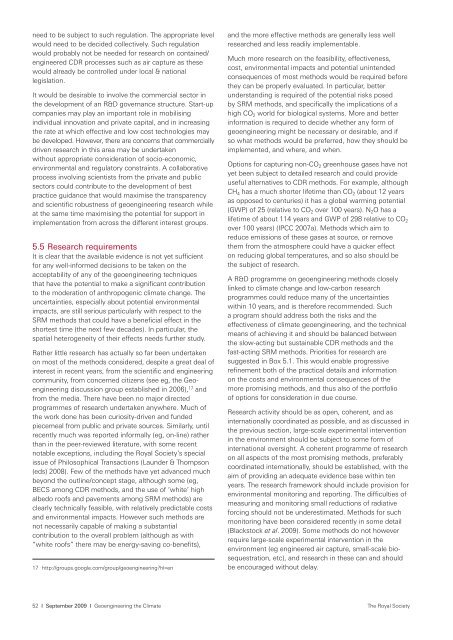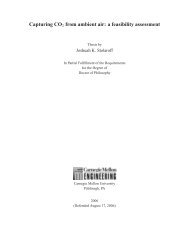Royal Society - David Keith
Royal Society - David Keith
Royal Society - David Keith
Create successful ePaper yourself
Turn your PDF publications into a flip-book with our unique Google optimized e-Paper software.
need to be subject to such regulation. The appropriate level<br />
would need to be decided collectively. Such regulation<br />
would probably not be needed for research on contained/<br />
engineered CDR processes such as air capture as these<br />
would already be controlled under local & national<br />
legislation.<br />
It would be desirable to involve the commercial sector in<br />
the development of an R&D governance structure. Start-up<br />
companies may play an important role in mobilising<br />
individual innovation and private capital, and in increasing<br />
the rate at which effective and low cost technologies may<br />
be developed. However, there are concerns that commercially<br />
driven research in this area may be undertaken<br />
without appropriate consideration of socio-economic,<br />
environmental and regulatory constraints. A collaborative<br />
process involving scientists from the private and public<br />
sectors could contribute to the development of best<br />
practice guidance that would maximise the transparency<br />
and scientific robustness of geoengineering research while<br />
at the same time maximising the potential for support in<br />
implementation from across the different interest groups.<br />
5.5 Research requirements<br />
It is clear that the available evidence is not yet sufficient<br />
for any well-informed decisions to be taken on the<br />
acceptability of any of the geoengineering techniques<br />
that have the potential to make a significant contribution<br />
to the moderation of anthropogenic climate change. The<br />
uncertainties, especially about potential environmental<br />
impacts, are still serious particularly with respect to the<br />
SRM methods that could have a beneficial effect in the<br />
shortest time (the next few decades). In particular, the<br />
spatial heterogeneity of their effects needs further study.<br />
Rather little research has actually so far been undertaken<br />
on most of the methods considered, despite a great deal of<br />
interest in recent years, from the scientific and engineering<br />
community, from concerned citizens (see eg, the Geoengineering<br />
discussion group established in 2006), 17 and<br />
from the media. There have been no major directed<br />
programmes of research undertaken anywhere. Much of<br />
the work done has been curiosity-driven and funded<br />
piecemeal from public and private sources. Similarly, until<br />
recently much was reported informally (eg, on-line) rather<br />
than in the peer-reviewed literature, with some recent<br />
notable exceptions, including the <strong>Royal</strong> <strong>Society</strong>’s special<br />
issue of Philosophical Transactions (Launder & Thompson<br />
(eds) 2008). Few of the methods have yet advanced much<br />
beyond the outline/concept stage, although some (eg,<br />
BECS among CDR methods, and the use of ‘white’ high<br />
albedo roofs and pavements among SRM methods) are<br />
clearly technically feasible, with relatively predictable costs<br />
and environmental impacts. However such methods are<br />
not necessarily capable of making a substantial<br />
contribution to the overall problem (although as with<br />
“white roofs” there may be energy-saving co-benefits),<br />
17 http://groups.google.com/group/geoengineering?hl=en<br />
and the more effective methods are generally less well<br />
researched and less readily implementable.<br />
Much more research on the feasibility, effectiveness,<br />
cost, environmental impacts and potential unintended<br />
consequences of most methods would be required before<br />
they can be properly evaluated. In particular, better<br />
understanding is required of the potential risks posed<br />
by SRM methods, and specifically the implications of a<br />
high CO 2 world for biological systems. More and better<br />
information is required to decide whether any form of<br />
geoengineering might be necessary or desirable, and if<br />
so what methods would be preferred, how they should be<br />
implemented, and where, and when.<br />
Options for capturing non-CO 2 greenhouse gases have not<br />
yet been subject to detailed research and could provide<br />
useful alternatives to CDR methods. For example, although<br />
CH 4 has a much shorter lifetime than CO 2 (about 12 years<br />
as opposed to centuries) it has a global warming potential<br />
(GWP) of 25 (relative to CO 2 over 100 years). N 2 O has a<br />
lifetime of about 114 years and GWP of 298 relative to CO 2<br />
over 100 years) (IPCC 2007a). Methods which aim to<br />
reduce emissions of these gases at source, or remove<br />
them from the atmosphere could have a quicker effect<br />
on reducing global temperatures, and so also should be<br />
the subject of research.<br />
A R&D programme on geoengineering methods closely<br />
linked to climate change and low-carbon research<br />
programmes could reduce many of the uncertainties<br />
within 10 years, and is therefore recommended. Such<br />
a program should address both the risks and the<br />
effectiveness of climate geoengineering, and the technical<br />
means of achieving it and should be balanced between<br />
the slow-acting but sustainable CDR methods and the<br />
fast-acting SRM methods. Priorities for research are<br />
suggested in Box 5.1. This would enable progressive<br />
refinement both of the practical details and information<br />
on the costs and environmental consequences of the<br />
more promising methods, and thus also of the portfolio<br />
of options for consideration in due course.<br />
Research activity should be as open, coherent, and as<br />
internationally coordinated as possible, and as discussed in<br />
the previous section, large-scale experimental intervention<br />
in the environment should be subject to some form of<br />
international oversight. A coherent programme of research<br />
on all aspects of the most promising methods, preferably<br />
coordinated internationally, should be established, with the<br />
aim of providing an adequate evidence base within ten<br />
years. The research framework should include provision for<br />
environmental monitoring and reporting. The difficulties of<br />
measuring and monitoring small reductions of radiative<br />
forcing should not be underestimated. Methods for such<br />
monitoring have been considered recently in some detail<br />
(Blackstock et al. 2009). Some methods do not however<br />
require large-scale experimental intervention in the<br />
environment (eg engineered air capture, small-scale biosequestration,<br />
etc), and research in these can and should<br />
be encouraged without delay.<br />
52 I September 2009 I Geoengineering the Climate The <strong>Royal</strong> <strong>Society</strong>








